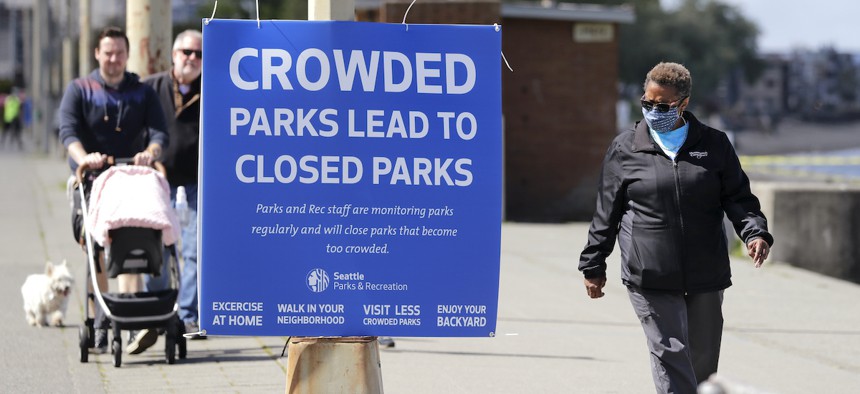Across the Country, Local Officials Hope New Rules Will Help Parks Reopen Safely

City guidelines for Seattle parks ask that people stay at least six feet apart, not to congregate and to keep moving to help prevent spread of the coronavirus. Associated Press
Dozens of municipalities are reopening park facilities, but requiring that visitors wear masks and adhere to social distancing to continue to fight the spread of Covid-19.
Parks in Miami-Dade County opened on Wednesday morning to residents for the first time since March—with a host of new regulations in place, all designed to allow people to enjoy time outdoors while preventing the spread of Covid-19.
Among the changes: park visitors must wear face masks, but can remove them during strenuous exercise. Basketball courts are open, but group games are banned, and anyone who wishes to play must bring their own ball. Four hundred security guards will be on hand to enforce the new policies, which Mayor Carlos Gimenez said were “zero tolerance.”
“We want to be able to get outdoors and have some fun, but you must not come into close contact,” Gimenez said Monday at a press conference announcing the reopening. “This is not, ‘I hope that you do this.’ You’re going to do this. If you follow these restrictions, your risk of getting infected is very, very low.”
Miami-Dade County in Florida is one of dozens of municipalities preparing to reopen park facilities that closed last month amid the spread of the novel coronavirus. Fifty-three percent of park and recreation agency leaders are currently working with public health officials to develop plans to reopen facilities and relaunch programs, according to data from the National Recreation and Park Association.
Most of those plans involve phased reopenings of spaces and facilities where park visitors can easily comply with social-distancing guidelines, followed by monitoring to ensure that transmission is not increasing, said Allison Colman, the nonprofit’s director of health.
“After that, it may be possible to move forward into the next phase, where some small group activities may be allowed,” she said. “It’s really localized in terms of these decisions, but one thing we are stressing is that physical distancing is going to be here for a long time and there’s got to be a plan in place for monitoring that physical distancing and making sure that people are adhering to it. It’s a combination of self-ownership, public responsibility and self-policing.”
A majority of parks have kept some facilities open to the public throughout the pandemic, including 86% of trails, according to data from NRPA. Reopening facilities where social distancing may be difficult—including restrooms, courts and pools— is a delicate balance between adhering to public health recommendations and serving the needs of constituents, including many who have been cooped up at home for more than a month. But it’s those weeks of strict social distancing, along with new information about the virus, that make it feasible to consider reopening parks now, said St. Louis County Executive Sam Page.
“We know that our parks are a relief valve for our community,” Page said Tuesday at a press conference announcing the reopening of 33 parks in the Missouri county. “Our kids can only watch so much Netflix or adults can only do so much homeschooling and parenting and education, and so many Zoom videos for their work product. But we want to thank our residents for staying diligent. We understand what we need to do in the direction to contain the spread of virus in our community.”
In Miami-Dade County, Gimenez crafted a reopening plan in collaboration with government officials and public health experts from area universities and the state Department of Health. They concluded the timing was right, he said, because the area’s health system has not been overwhelmed by coronavirus patients and still has adequate numbers of beds available to treat new cases. The plan also allows for flexibility in the event that situation shifts.
“Nothing here is written in stone,” he said. “If we see trends that trouble us, we can take other measures.”
Other cities have taken similar measures. San Diego reopened some parks last week for “walking, jogging and individual passive activities,” but Mayor Kevin Faulconer warned that he wouldn’t hesitate to reverse course if residents failed to obey public health orders.
“We closed all parks and beaches last month because too many San Diegans were gathering and potentially spreading Covid-19, overwhelming the ability of officers to enforce public safety rules,” he said in a statement. “Since late March San Diegans have been following the rules and our hospitals have been able to meet patient demand...Based on how the public responds to this change we will determine what the next steps could be in coordination with our public health officials.”
With proper monitoring in place, and with expectations communicated clearly to residents, it’s possible that parks can reopen safely and successfully—which can offer myriad benefits to communities, Colman said. But it will require broad adherence to new rules.
“I think when these spaces and facilities are able to be safely used, and when physical distancing is able to take place in those spaces, it is more important than ever that they stay open,” she said. “People need space to get outside, get fresh air, and clear their minds. The optimist in me wants to say this is possible, but it really comes down to taking personal responsibility, and having plans in place to monitor and enforce, and educating the public about the importance of it.”
OTHER STORIES on Route Fifty:
Kate Elizabeth Queram is a Staff Correspondent for Route Fifty and is based in Washington, D.C.
NEXT STORY: Free Clinics Try To Fill Gaps As COVID Sweeps Away Job-Based Insurance





